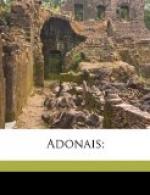’As the blue bells
Of hyacinth tell Apollo’s written grief.’
1. 8. Amid the faint companions of their youth. In Shelley’s edition the words are ‘Amid the drooping comrades,’ &c. The change was made under the same circumstances as noted on p. 105. Whether it is a change for the better may admit of some question. The faint companions of the youth of the hyacinth and the narcissus must be other flowers, such as Spring had thrown down.
1. 9. With dew all turned to tears,—odour, to sighing ruth. The dew upon the hyacinth and narcissus is converted into tears: they exhale sighs, instead of fragrance. All this is in rather a falsetto tone. It has some resemblance to the more simple and touching phrase in the Elegy by Moschus (p. 65): ’Ye flowers, now in sad clusters breathe yourselves away.’
+Stanza 17+, 1. 1. Thy spirits sister, the lorn nightingale, Mourns not her mate, &c. The reason for calling the nightingale the sister of the spirit of Keats (Adonais) does not perhaps go beyond this—that, as the nightingale is a supreme songster among birds, so was Keats a supreme songster among men. It is possible however—and one willingly supposes so—that Shelley singled out the nightingale for mention, in recognition of the consummate beauty of Keats’s Ode to the Nightingale, published in the same volume with Hyperion. The epithet ‘lorn’ may also be noted in the same connexion; as Keats’s Ode terminates with a celebrated passage in which ‘forlorn’ is the leading word (but not as an epithet for the nightingale itself)—
‘Forlorn!—the very word is as a knell,’ &c.
The nightingale is also introduced into the Elegy of Moschus for Bion; ‘Ye nightingales that lament,’ &c. (p. 65), and ’Nor ever sang so sweet the nightingale on the cliffs.’ Poets are fond of speaking of the nightingale as being the hen-bird, and Shelley follows this precedent. It is a fallacy, for the songster is always the cock-bird.




